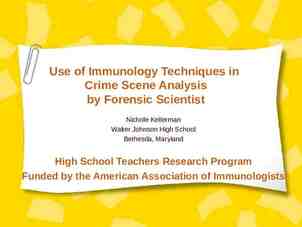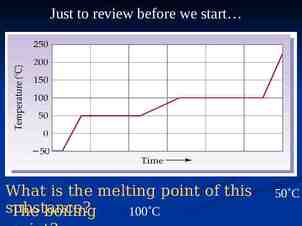Autoimmune Diseases Henry O. Ogedegbe, PhD., C(ASCP)SC Department
47 Slides74.00 KB

Autoimmune Diseases Henry O. Ogedegbe, PhD., C(ASCP)SC Department of EHMCS

Learning Objectives Upon completion of these materials the student will be able to: Describe contributive factors to autoimmune diseases Distinguish organ specific and systemic autoimmune diseases with examples of each Describe the effects of SLE on the body List four types of autoantibodies found in lupus and describe pattern seen in IFA testing Discuss the symptoms of rheumatoid arthritis Describe the characteristics of the Abs found in rheumatoid arthritis

Learning Objectives Differentiate Hashimoto’s thyroiditis and Graves’ disease on the basis of lab findings and immune mechanism List the main Abs tested for in Graves’ and Hashimoto’s diseases and describe testing procedures Relate genetic susceptibility to the development of insulin dependent diabetes mellitus Explain immunologic mechanism known to cause destruction of cells in insulin-dependent diabetes mellitus Discuss immunologic findings in multiple sclerosis, myasthenia gravis and Goodpasture’s syndrome

Introduction Autoimmune diseases are the result of damage to the body by the presence of autoantibodies or autoreactive cells About 2% of the population are affected by such diseases There is a breakdown of self tolerance in these individuals Self tolerance is brought about by such mechanisms as clonal deletion of relevant effector cells, active regulation by TS cells and regulation through idiotypic networks Majority of T cells that are processed through the thymus do not survive. Self reactive T cells are destroyed Loss of TS cells may encourage the production of autoAbs

Introduction MHC molecules influence Ag recognition or nonrecognition by determining peptide that can be presented to T cells The expression of class II molecules on host cells may result in presentation of self Ags for which there is no tolerance In several diseases, there are host cells that exhibit class II molecules on their surfaces after inflammatory response Such cells may function as Ag presenting cells for their own cellular proteins

Introduction Genetic variation in MHC Ag may account for increased susceptibility in certain individuals Idiotypic network may also play a part in autoimmune diseases This refers to situations whereby antibodies are produced against antibodies When an Ab is produced for the first time, the variable region may be seen as foreign by the host The host may then produce antibodies against it The anti-idiotypic Ab may have reactivity against self Ags

Introduction Anti-idiotypic Abs are found in diseases such as myasthenia gravis, diabetes mellitus, and Graves’ disease The anti-idiotypic Abs may mimic the original Ab and combine with the receptor for that Ag Defects in natural killer cells, in the secretion of ILs, in phagocytosis and complements may also contribute Hormones especially estrogen have been found to enhance B-cell activation and suppress regulator activities of T cell Environmental conditions such as infectious agents like viruses, bacteria and drugs contribute to autoimmunity

Systemic Lupus Erythematosus It is a chronic systemic inflammatory disease marked by alternating exacerbation and remissions Approximately 1 in every 2000 individuals are affected Age of onset is usually b/w 20 and 40 yrs of age Women are much more likely than men to be stricken by a margin of 13 to 1 Etiology is unknown but may be due to genetic and environmental factors In whites, it is strongly associated to with HLA-DR3 or DR2 and DQB1

Systemic Lupus Erythematosus Clinical Signs: The first signs to appear are usually nonspecific such as fatigue, weight loss, malaise, fever, and anorexia Joint involvement of small joints of the hands, wrist and knees is reported in over 90% of cases A skin manifestation of an erythematous rash may appear in the area of body exposed to UV light A classic butterfly rash across the nose and cheeks which is responsible for the name lupus may appear Some patients may also exhibit renal involvement

Systemic Lupus Erythematosus Renal involvement is usually in the form of lesions the most dangerous of which is glomerulonephritis Immune complexes may deposit in the subendothelial tissue and thickening of the basement membrane results All of these can result in renal failure and death There might also be cardiac involvement with pericarditis, tachycardia, or ventricular enlargement. CNS manifestation such as seizures, psychoses, or depression Hematologic abnormalities such as anemia, leukopenia or lymphopenia are exhibited

Systemic Lupus Erythematosus Immunological Findings: The LE cell was discovered by Malcolm and Hargraves in 1948. The LE cell is a neutrophil that has engulfed the antibodycoated nucleus of another neutrophil The first anti-DNA antibody was discovered 9 years later SLE is associated with more than 28 autoantibodies Lupus patients appear to have overactive B cells especially the subset with the CD5 marker which increase in number

Systemic Lupus Erythematosus The increased prevalence of the disease in women may be traced to the fact that estrogen enhance B cell activity Estrogen also suppresses regulator activities of T cells as a result, there is a decrease in the absolute number of T cells Complement is activated which results in decrease in the serum level of complement components At the same time there is an increase in the level of breakdown products of complements such as C3d and C3a IgG is most pathogenic and it forms complexes that are deposited in the glomerular basement membrane

Systemic Lupus Erythematosus Accumulation of immune complex with complement activation is responsible for the damage to the kidney Drug induced lupus differs from the chronic form of the disease: when the drug is withdrawn symptoms disappear It is a milder form of the disease and manifest as arthritis or rashes Drugs that have been implicated include procainamide hydrochloride, hydralazine hydrochloride, methyldopa etc.

Systemic Lupus Erythematosus Laboratory Diagnosis of SLE: A screening test for antinuclear antibody (ANA) is usually the first test done Fluorescent antinuclear antibody (FANA) testing is most widely used The test is sensitive but the specificity is low because many of the Abs are associated with other diseases The test is an indirect IFA test which employs antihuman globulin tagged with a fluorescent marker. About 5% of healthy individuals and b/w 10 and 30% of elderly individuals test positive

Systemic Lupus Erythematosus If FANA is positive, then a profile testing should be done for individual Abs More than 99% of patients with SLE will have a positive result for one or more tests

Systemic Lupus Erythematosus Double-stranded DNA (ds-DNA): These Abs are the most specific for SLE and are seen only in patients with SLE Found in only 50 to 80% of cases but when seen, they are diagnostic of the disease Abs to ds-DNA produce a peripheral staining pattern in IFA A sensitive assay for ds-DNA utilizes Crithidia luciliae, a hemoflagellate as the substrate A positive test is indicated by a brightly stained kinetoplast with a dilution of 1:10 or greater of patient serum

Systemic Lupus Erythematosus Antihistone antibody: Histone is a major component of chromatin This antibody is found in lupus patients It binds to DNA and may be found in all cases of drug induced lupus If no other Abs are present, this may support a diagnosis of drug induced lupus The Abs may be detected by IFA, RIA or EIA

Systemic Lupus Erythematosus Antibodies are also produced against DNA complexed to histone known as deoxyribonucleoprotein (DNP) The antibody is thought to be identical to the LE factor or phenomenon It appears in 70 to 90% of patients with SLE A slide method using latex particle coated with DNP have been used in a simple slide agglutination test for SLE Anti-Sm antibody: Antibody to extractable nuclear antigen was first described in a patient named Smith hence it is called anti-Sm

Systemic Lupus Erythematosus Extractable nuclear Ags are small nuclear riboproteins that are associated with uridine-rich ribonucleic acid (RNA) The Ab is specific for SLE and not found in other autoimmune diseases Anti-Sm can be measured by double diffusion, passive hemagglutination, and EIA SS-A/Ro and SS-B/La are also members of the family of extractable nuclear antigens. Antibody to SS-A/Ro appears in 25 to 40% of patients with SLE

Systemic Lupus Erythematosus It is found in patients with cutaneous manifestations of SLE SS-B/La is found in 10 to 15% of patients with SLE and all of them have anti-SS-A/Ro Antibodies are detected by the IFA test with the use of human tissue culture cells e.g. (Hep-2) human epidermal Anti-nRNP: Anti-nRNP produces a finely speckled IFA pattern RNP is a nuclear RNA which is found in association with seven to eight nonhistone proteins

Systemic Lupus Erythematosus The antibody is also found in high titer in individuals with mixed connective tissue disease and other autoimmune diseases The antibody can be measured by double diffusion, passive hemaglutination and EIA and IFA Treatment: If the primary symptom is fever or arthritis a high dose of aspirin or other anti-inflammatory drug may bring relief May also use antimalarials and topical steroids. Other drugs include cyclophosphamide, methotrexate etc.

Rheumatoid Arthritis Rheumatoid arthritis is a systemic autoimmune disorder It involves the synovial membrane of multiple joints Women are more likely to be affected than men and usually strikes between the ages of 20 and 40 Spontaneous remission may be experienced by some patients otherwise the disease may progress and result in deformity and disability RA has been associated with certain of the HLA class II molecules. HLA-DR1 and DR4 occur in 70% of patients with RA

Rheumatoid Arthritis Clinical Signs: Diagnosis of RA is based on the 1987 criteria established by the American College of Rheumatology Symptoms include morning stiffness around the joints lasting at least 1 hour, swelling of the soft tissue around three or more joints Others include swelling of the proximal interphalangeal, metacarpophalangeal, or wrist joints, symetric arthritis, subcutaneous nodules, a positive RF test Also included is a radiographic evidence of erosion of the joints of the hands, the wrist, or both

Rheumatoid Arthritis Usually begins with nonspecific symptoms such as fever, malaise, weight loss, and transient joint pain Stiffness and joint pain that gradually improves during the day are characteristics exhibited by most patients Joint are involved progressively to larger joints in a symmetric manner from the knees, hips, elbows, shoulders and cervical spine About 25% of patients have nodules over the bones Nodules may also be found in the myocardium, pericardium, heart valve, pleural, lungs, spleen, and larynx

Rheumatoid Arthritis Immunologic Findings: The main immunologic finding is the presence of RF RF is a 19S Ab directed against the Fc portion of IgG The Ab is not specific for RA as it is found in other diseases such as SLE, scleroderma, Sjögren’s syndrome and B cell lymphoproliferative disorders It has been suggested that RF may be anti-idiotypic antibodies involved in the regulation of immune response In RA, polyclonal activation of B cells may occur resulting in overwhelming amount of antibody to IgG

Rheumatoid Arthritis Other autoAbs associated with RA include ANA, anticollagen Abs, Abs against cytoskeleton filamentous proteins etc. These Abs may cause immune complex formation with the activation of complement which contribute to pathogenesis Joint damage is due to invasion of inflammatory cells such as neutrophils, and macrophages Proliferation of fibroblast, macrophages, mast cells, and stellar cells result in the formation of a pannus, an organized mass of cells that grow into the joint space

Rheumatoid Arthritis Laboratory Diagnosis of Rheumatoid Arthritis: Diagnosis is based on a combination of clinical manifestations, radiographic findings and lab tests Laboratory screening test for RF using sheep red cells or latex particles are available and simple to perform Quantitative test are also available which involve nephelometry and ELISA techniques RF is found in other diseases such as syphilis, viral infections, leprosy, chronic liver disease, neoplasm and other inflammatory processes

Rheumatoid Arthritis The RF test is thus not a specific test for RA and about 10% of patient with the disease test negative for RF C-reactive protein and ESR are usually elevated and complements are normal or elevated Treatment: Treatment include palliatives with rest and nonsteroidal antiinflammatory drugs like salicylates and ibuprofen Slow-acting antirheumatic drugs (SAARDS) may also be used to treat the condition New therapy include the use of monoclonal Abs that target T cells

Hashimoto’s Thyroiditis Hashimoto’s thyroiditis and Graves’ disease are organ specific autoimmune diseases Both diseases interfere with the thyroid gland function The thyroid gland located in the anterior region of the neck consist of units called follicles Follicles are lined with cuboidal epithelial cells and filled with colloid The primary constituent of colloid is thyroglobulin which is made up of triiodothyronine (T3) thyroxine (T4) TRH acts on the pituitary gland to induce the release of TSH

Hashimoto’s Thyroiditis TSH binds to receptors on the cell membrane of the thyroid gland causing break down of thyroglobulin into T3 and T4 AutoAbs may interfere with this process and cause under or overactivity of the thyroid Hashimoto’s thyroditis is most often seen in women between the ages of 30 and 40 years Patients develop a combination of goiter or enlarged thyroid, hypothyroidism and thyroid autoantibodies An association with HLA antigens DR4 and DR5 has been noted. DQA1 and DQB1 genes seem to confer resistance

Hashimoto’s Thyroiditis Immunologic Findings: Lymphocytic infiltration is seen with development of germinal centers that almost replace the normal glandular architecture of the thyroid Cell infiltrates include T and B cells, macrophages and plasma cells Both CD4 and CD8 cells are found thus the disease is characterized by a cellular and a humoral response Autoantibodies are found in up to 80% of cases

Hashimoto’s Thyroiditis Laboratory Testing: The autoantibodies present include Abs to thyroglobulin and to thyroid microsomal antigen now known as thyroid peroxidase Some peroxidase Abs inhibit enzyme activity while others may mediate the cytotoxicity due to natural killer cells Abs to thyroglobulin help to produce hypothyroid conditions Other Abs include colloid Ab (CA2) thyrotropin-binding inhibitory immunoglobulin (TBII)

Hashimoto’s Thyroiditis Others are thyroid stimulating immunoglobulin (TSI) and thyroid growth-stimulating immunoglobulin (TGSI) Peroxidase Abs can be measured by particle agglutination assays, complement fixation, RIA and Indirect IFA Abs to thyroglobulin can be measured by precipitaion in agar, indirect IFA, passive agglutination, RIA, and EIA Indirect IFA use human or monkey thyroid tissue fixed to a slide Antithyroglobulin Abs are found in about 80% of patients with the disease

Graves’ Disease Graves’ disease is another autoimmune disease that affects the thyroid gland Graves’ disease produces hyperthyroidism It the most common cause of hyperthyroidism and affects about 0.5% of the population Women are more susceptible than men by a margin of 7:1 and usually present between the ages of 30 and 40. In whites, the disease is associated with the HLA antigen DR3 while in Asians HLA Bw35 and Bw36 occur more frequently

Graves’ Disease HLA DQB1 appears to confer resistance to the disease Clinical Signs: Disease is presented as thyrotoxicosis with a diffusely enlarged goiter that is soft instead of rubbery Signs include nervousness, insomnia, depression, weight loss, heat intolerance, sweating, rapid heart beat Other signs include fatigue, cardiac dysrhythmias, restlessness, and exopthalmus

Graves’ Disease Immunologic Findings: The thyroid presents with Hyperplasia with a patchy infiltration of lymphocytes Both CD4 and CD8 cells are present and the T cells appear to play a central role in the pathogenesis of the disease The most significant Ab present is thyroid stimulating hormone receptor antibody (TRab) Ag-Ab combination result in the stimulation of the receptor resulting in the release of the thyroid hormones Another group of Abs called thyroid stimulating antibodies or immunoglobulins (TSab or TSI) may have different specificity

Graves’ Disease Laboratory Diagnosis: A key finding in Graves’ disease is elevated levels of total and free T3 and T4 In addition, TSH levels are low due to Ab stimulation of the thyroid Measurement of the thyroid Abs may be undertaken if the above assays are unclear Treatment: Antithyroid medication may be employed. Radioiodine which emits beta particles may be used. Surgery is also an option.

Insulin-Dependent Diabetes This disease is characterized by insufficient production of insulin due to an autoimmune destruction of the beta cells of the pancreas Peak onset is b/w 10 and 14 years of age Disease may be attributed to genetic and environmental conditions About 95% of white diabetics carry the HLA-DR3 or DR4 genes It appears that true susceptibility genes for IDDM may occur in the HLA-DQ region

Insulin-Dependent Diabetes Viral infections have been linked with diabetes Mumps virus, rubella virus, CMV, and Coxsakie B4 virus have all been inconclusively linked to diabetes Congenital rubella infection is the only one for which a link has been definitively identified There appears to be similarity between coxsakie viral protein P2C and the enzyme glutamic acid decarboxylase. Antibodies are formed against glutamic acid decarboxylase in IDDM Molecular mimicry could initiate Ab production against self Ag

Insulin-Dependent Diabetes Immunopathology: Inflammation of the islets of Langerhans in the pancreas leads to fibrosis and destruction of most of the beta cells CD4 and CD8 B cells and macrophages are all involved in the destructive process of the islet cells Cellular and humoral immunity are involved in this process The subset of T cells that is activated determines whether the response is cellular or humoral

Insulin-Dependent Diabetes Laboratory Testing: IDDM is usually diagnosed by the presence of hyperglycemia Abs to islet cells may be screened for by indirect IFA with human or rat islet cells Islet cell may be detected in the sera of newly diagnosed diabetic cases Abs to insulin may be detected by ELISA or RIA methods

Insulin-Dependent Diabetes Treatment: Insulin has been the standard form of treatment New treatment methods center around the use of immunosuppressive agents Agents that have been tried include azathioprine, cyclosporine A and prednisone All these agents have potentially toxic effects

Multiple Sclerosis Destruction of the myelin sheath results in the formation of lesions known as plaques in the white matter of the brain and spinal cord Genetic and environmental factors predispose one to this disease MS is associated with the inheritance of HLA antigen DRw15 and DRw6 An inflammatory response to bacteria or virus may trigger the autoimmune process Disease is most often seen in those b/w the ages of 20 & 50 and is more common in women

Multiple Sclerosis 90% of patients alternate between remissions and relapses for many years Within the plaques, CD4 cells, plasma cells and macrophages are found along with immunoglobulin Immunoglobulin is increased in the spinal fluid in 60 to 80% of patients They usually produce oligoclonal bands on protein electrophoresis RIA is used to detect the Abs Therapy include use of corticosteroids

Myasthenia Gravis Symptoms of disease include facial weakness, difficulty in chewing, and swallowing, difficulty breathing Others include inability to maintain support of the trunk, the neck or the head Antibody mediated damage to the acetylcholine receptors in the skeletal muscle leads to muscle weakness May be associated with the presence of other autoimmune diseases such as SLE Appears to be linked with either HLA-B8 or DRw3 antigens

Myasthenia Gravis 80 to 90% of patients have Abs to acetylcholine receptors which may be the main contributor to pathogenesis Combination of the Abs to the receptors blocks the binding of acetylcholine which destroy the receptors Abs can be detected with RIA methods Anticholinesterase agents are employed in therapy

Goodpasture’s Syndrome Goodpasture’s syndrome is a glomerulonephritis due to Abs reacting specifically with Ags in the kidney Necrosis of the glomerulus is triggered by an Ab that reacts with glycoprotein present in the basement membrane of the glomerulus Results in immune complex deposit and complement fixation which causes the damage to the kidney This may eventually produce renal failure






